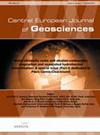The volcanic-subvolcanic rocks of the fernando de noronha archipelago, southern atlantic ocean: Mineral chemistry
引用次数: 8
Abstract
Fernando de Noronha archipelago presents an older Remédios Formation with subvolcanic intrusions, belonging to two different alkaline series, the sodic (undersaturated: basanites, tephrites, essexites, tephriphonolites, phonolites), and potassic ones (mildly undersaturated to silicic, with alkali basalts, basaltic trachyandesites, trachyandesites, trachytes), and lamprophyres. The upper Quixaba Formation presents nephelinite flows and basanites. A third minor unit, São José, is constituted by basanites carrying mantle xenoliths. Magnesian olivines occur in the Remédios basanites and alkali basalts, and in nephelinites. Melilites are present as groundmass grains in melilite melanephelinites (MEM). Clinopyroxenes (cpx) are mostly salites to titaniferous salites (Remédios sodic series), grading into aegirines in the differentiated aphyric phonolites. Cpx in the lamprophyres show disequilibrium textures. In the Quixaba flows, cpx are salites, enriched in Mg (especially in MEM). Amphiboles, remarkably, are common in tephriphonolites and phonolites and in basaltic trachyandesites, sometimes with disequilibrum zoning textures, and a conspicuous phase in lamprophyres. Dark micas are present as groundmass plates in MEM, OLM and PYM (olivine and pyroxene melanephelinites), with compositional variety (enriched in Ti, Ba, Sr) depending on the composition of the parent rock; BaO can be as high as 16–19%. Feldspars crystallize as calcic plagioclases, sanidines and anorthoclases, depending on the rock types, as phenocrysts and in groundmass, both in Quixaba and Remédios rocks; they are absent in nephelinites. Nephelines are found in Remédios sodic series types and Quixaba rocks. Haüyne and noseane are rarely observed in Remédios rocks.南大西洋费尔南多迪诺罗尼亚群岛的火山-次火山岩:矿物化学
Fernando de Noronha群岛呈现一个较老的remsamdios组,含次火山侵入,属于两个不同的碱性系列,即钠质(不饱和:玄武岩、软质岩、铁质岩、软纹岩、空纹岩)和钾质(轻度不饱和至硅质,含碱性玄武岩、玄武岩粗质山岩、粗质山岩、粗质山岩)和煌斑岩。上基沙巴组发育辉石流和玄武岩。第三个小单元,o jos,由携带地幔捕虏体的玄武岩组成。镁质橄榄石赋存于雷姆萨迪奥斯玄武岩、碱玄武岩和钠辉石中。melmelite melepelites (MEM)中melmelite melepelites (MEM)以基质颗粒的形式存在。斜辉石岩(cpx)多为盐岩至含钛盐岩(remdios sodic系列),在已分化的葡萄质phonolites中分级为炔类。煌斑岩中的Cpx呈不平衡结构。在Quixaba流中,cpx为盐岩,富镁(特别是MEM)。值得注意的是,角闪石在绢纹岩、绢纹岩和玄武质粗面岩中很常见,有时具有不平衡分带结构,在煌斑岩中有一个明显的阶段。暗云母在MEM、OLM和PYM(橄榄石和辉石黑绿斑岩)中以地质体板块形式存在,其成分随母岩组成的不同而变化(富Ti、Ba、Sr);BaO可高达16-19%。长石结晶为钙斜长石、钾长石和斜长石,视岩石类型而定,在基赫巴和雷姆萨迪奥斯岩石中均为斑晶和地质体;它们在钠辉石中不存在。在remsamdios钠质系列类型和Quixaba岩石中发现了霞石。在remsamdios岩石中很少观察到hayne和noseane。
本文章由计算机程序翻译,如有差异,请以英文原文为准。
求助全文
约1分钟内获得全文
求助全文
来源期刊

Central European Journal of Geosciences
GEOSCIENCES, MULTIDISCIPLINARY-
自引率
0.00%
发文量
0
审稿时长
>12 weeks
 求助内容:
求助内容: 应助结果提醒方式:
应助结果提醒方式:


